On February 1, 2022, the Armenian Energy Exchange (AEX) software (Wholesale Electricity Market Management System) officially went live, ushering in a new era of technological advancement for the Settlement Center CJSC (a company owned by the Ministry of Territorial Administration and Infrastructure), and significantly increasing market liberalization and cross-border trade for the electricity producers, suppliers, and purchasers of energy throughout Armenia. The launch of the AEX will assist the Government of Armenia, the Public Services Regulatory Commission, and the Market Participants in shaping a conducive investment climate, fostering competition in the domestic market, and creating new opportunities for regional trade.
Following Armenian independence from The Soviet Union in 1991, country-wide efforts to liberalize markets, including the energy market began. USAID/Armenia assisted with several of these efforts, including the establishment of an independent energy regulator, helping to increase competition in the electricity and gas sectors, initiating large-scale privatization of energy generation and distribution, and substantially improving the delivery of electricity across the country. During this process over the past couple of decades, another challenge emerged. Due to the ageing infrastructure in the country and the Metsamor Nuclear Plant, a Soviet-era power plant which produced a significant amount of Armenia’s energy, Armenia was creating an energy surplus, and thus wasting energy, as it had no mechanism to facilitate the export of electricity to neighboring countries such as Georgia. Addressing this challenge, along with continued market liberalization, and increasing the investment opportunities for clean energy in Armenia became the focus of the recent USAID/Armenia project.
In June 2019, Synergy began work, via subcontract to Tetra Tech ES, on the USAID/Armenia funded Market Liberalization and Electricity Trade (MLET) Program. The goal of the program is to diversify the energy sources within Armenia, make the sector attractive for clean energy investment through technological advancement, increase energy independence, and strengthen regional economic integration through the creation of trade mechanisms.
Synergy was tasked with the design, development, pilot roll-out, future technical support and Market Participant training of the AEX, a system custom built for the wholesale energy market of Armenia. This month, the AEX officially launched. The system was implemented for the Settlement Center in Armenia and manages the entire wholesale energy market. Like every market, it has two sides it manages, the demand and supply of energy, and the consumers and purchasers of energy. The Settlement Center handles all transactions between these two sides of the market in Armenia, and the AEX is the platform by which the entire market is facilitated.
The AEX MMS has 5 core modules:
Users Database and Market Participant Management Module – The AEX provides User Management, licensing, energy metering, and financial guarantee information on the suppliers and purchasers of energy.
The Market Module – The AEX fully facilitates the trading of energy in different segments of the Market.
Settlements Module – The AEX executes transactions, from bilateral contracts, online auction management, economic modeling, placing, and executing of bids, and settling transactions via contracts and invoices.
Operations Module – The AEX supports the Market Server Provider, setting and dynamically changing Tariffs, Service fees and other system validations.
Monitoring Module – The AEX provides a suite of statistical analysis features that market participants, potential investors, or government personnel can use to better understand the energy market. Dashboards and custom reports can be created on a wide variety of different segments of the energy market.
Within the 5 Core modules, the AEX MMS supports 9 fundamental functionalities:
- Online registration of Market Participants
- Management of balance groups and schedules
- Electronic registration and confirmation of bilateral contracts
- Day-ahead trading and the online auction toolset
- Automatic settlement of imbalance and related service charges
- Invoicing and financial operations management
- Market monitoring and analysis
- Real-time metering data collection and allocation
- Transaction allocation (daily nominations per delivery point)
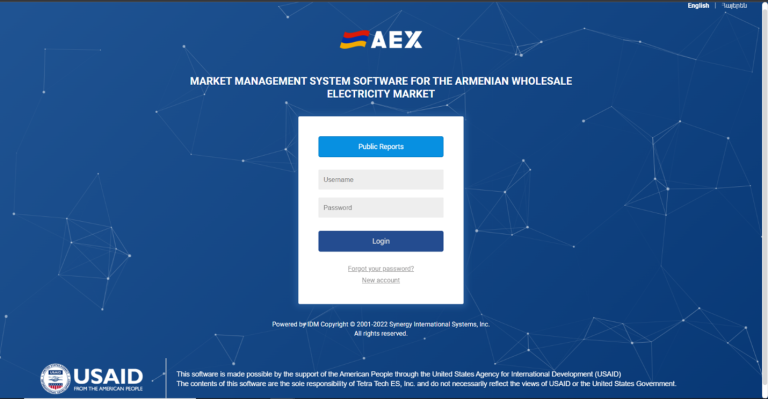
Users Database and Market Participant Management
A user begins their interaction with the AEX by logging in and creating a profile. These users are stored in the system as “Market Participants” (either buyers or sellers of energy). The system stores core business information about each market participant, including metering information and all legal licenses needed to buy and sell units of energy. Depending on the profile of the market participant, the system will prompt users to upload different pieces of business information to verify their ability to participate in the energy market.
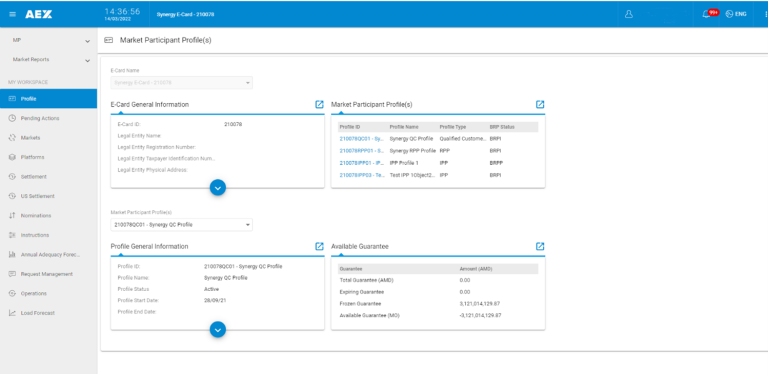
Market Module
The core of the AEX is the market module. This module facilitates the wholesale trading of energy throughout Armenia and with key economic partners such as Georgia. Within the Markets module, bilateral contract and energy auctions are conducted. The system generates contracts and payment acts, can collect signatures on these documents, and send fully executed contracts to the market participants. The market module also tracks the day-ahead market. This feature is perhaps one of the most important features of the system. The system tracks the day ahead supply and demand of energy, AKA, the forecast for the availability of electricity for the day ahead. These statistics tell market participants if an energy surplus will be created, and thus to instigate trade with international market participants from Georgia or other countries.

The system creates real-time economic forecasts of supply and demand, setting a unit price based on the supply and demand curve. The real-time economic models of the energy market calculate and adjust to market forces every 60 minutes. The system operates as a commodity exchange, opening at the Armenian market open, and closing at market close (X AM to X PM, Monday to Friday). The system also has all energy regulations from the Public Services Regulatory Commission built in, such as price caps on units of electricity given certain economic situations, and any other regulations.
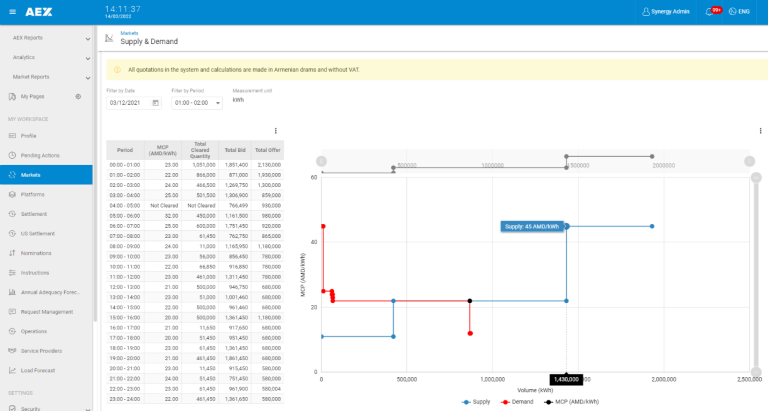
Settlement Module
The Settlement module within the AEX tracks the payments of energy transactions and services provided, ensuring the completion of trades. This feature of the system tracks all energy metering in Armenia, allowing for metering management of energy grid levels, and helps inform market participants’ decisions about energy purchases. This module also includes a floating guarantee account, which tracks each firm involved in the trading of energy, and once an energy purchase is completed, the purchasing firm’s guarantee is reduced from their stored finances in the system. This works as an energy trading clearing house.
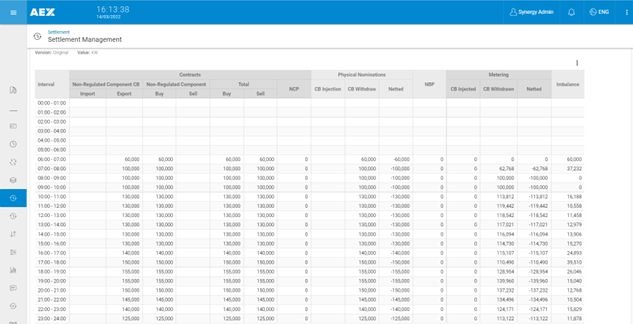
The settlements module essentially acts as a contract execution mechanism, making sure both energy suppliers and purchasers can approach transactions with confidence, knowing money and units of energy will change hands efficiently, transparently, and successfully.
Operations Module
The Operations module within the AEX helps the Market Operator to set and update business-critical system validation, energy tariffs and market Service fee via a web-based interface. This allow system to be flexible with changes and stay compatible with Market Rules.
Monitoring
The AEX tracks, in real-time, every firm in the market, both suppliers and purchasers, and how much energy each firm produces, and how much energy each firm purchases. This allows for a comprehensive overview of the entire energy market. The system is built with highly advanced statistical and analytical capabilities to glean insights from the Armenian energy market.
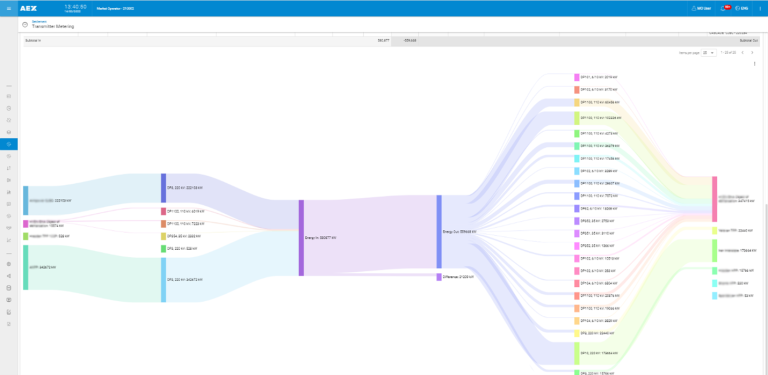
Energy quantity is dynamically tracked over time in the AEX. Because this system serves as the central system for all economic activity related to the exchange of energy in Armenia, the quantity of energy being produced at any given time, and over time, can be tracked and reported on. Both energy consumption, and energy production are tracked in real time. Day-ahead market predictions will improve over time as the AEX compares past day-ahead market predictions with actual results.
Outlook – AEX MMS and Renewable Energy/Increased Energy Investment
Because the AEX enables a comprehensive look at the economics of the energy market, the value of clean energy production is quantitatively demonstrated. The system helps the transition to sustainable energy in Armenia in two main ways:
- Through features such as the day-ahead market, Armenia will now have more optimal production and consumption of energy through the economic analysis provided by the system. This will in turn lead to significantly less wasted energy.
- The system facilitates a more liberalized energy market, thus creating more competition and lowering prices. Renewable energy, such as hydropower, has the lowest production cost per unit of electricity in the country, thus, the economic analysis provided by the AEX MMS should help shift investment towards renewable energy production as new and incumbent firms chase new economic opportunities. The Government of Armenia will be able to track over time, through the system, how much energy production shifts to renewable sources in the coming years, as all countries seek to fight climate change through renewable energy.


